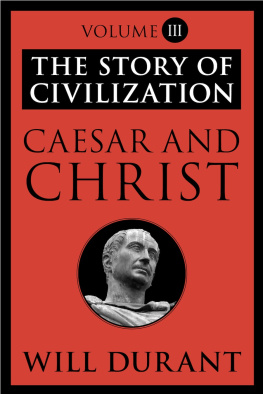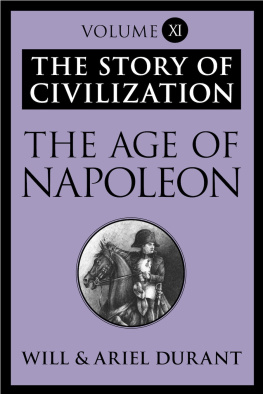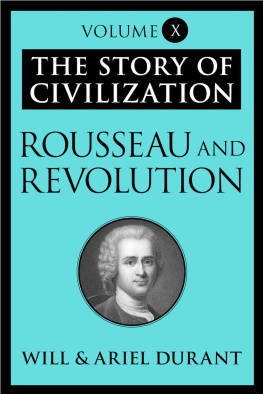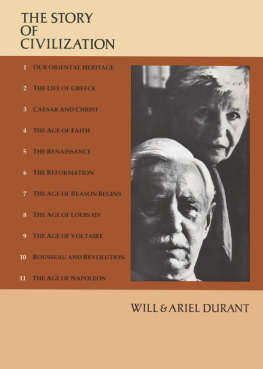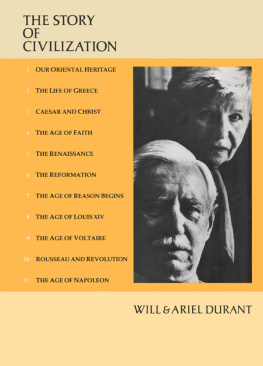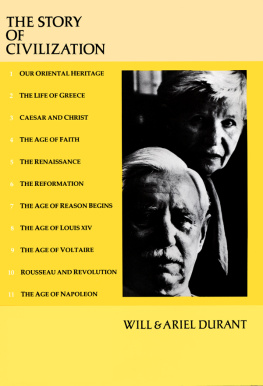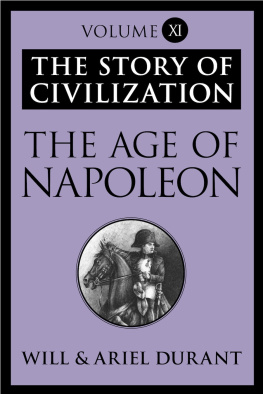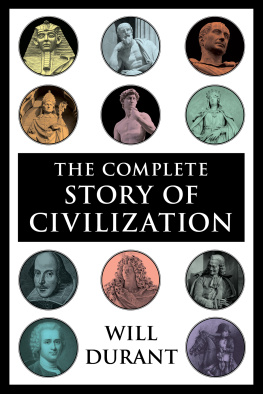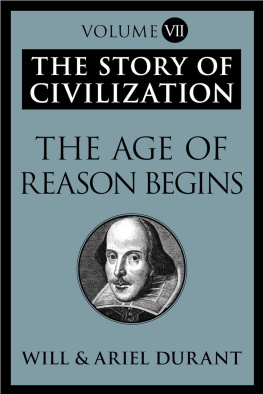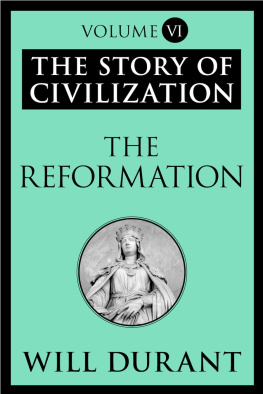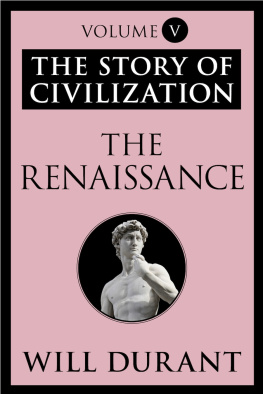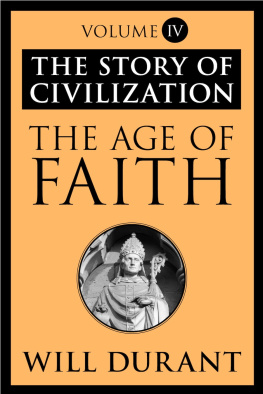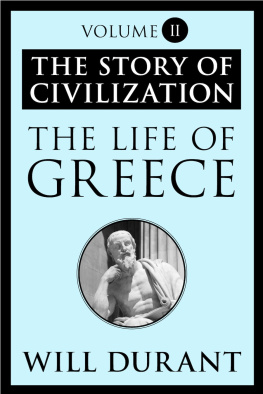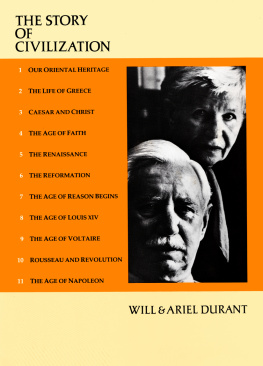Will Durant - The Story of Civilization Volume III: Caesar and Christ
Here you can read online Will Durant - The Story of Civilization Volume III: Caesar and Christ full text of the book (entire story) in english for free. Download pdf and epub, get meaning, cover and reviews about this ebook. year: 0, publisher: Simon & Schuster, genre: History. Description of the work, (preface) as well as reviews are available. Best literature library LitArk.com created for fans of good reading and offers a wide selection of genres:
Romance novel
Science fiction
Adventure
Detective
Science
History
Home and family
Prose
Art
Politics
Computer
Non-fiction
Religion
Business
Children
Humor
Choose a favorite category and find really read worthwhile books. Enjoy immersion in the world of imagination, feel the emotions of the characters or learn something new for yourself, make an fascinating discovery.
- Book:The Story of Civilization Volume III: Caesar and Christ
- Author:
- Publisher:Simon & Schuster
- Genre:
- Year:0
- Rating:4 / 5
- Favourites:Add to favourites
- Your mark:
- 80
- 1
- 2
- 3
- 4
- 5
The Story of Civilization Volume III: Caesar and Christ: summary, description and annotation
We offer to read an annotation, description, summary or preface (depends on what the author of the book "The Story of Civilization Volume III: Caesar and Christ" wrote himself). If you haven't found the necessary information about the book — write in the comments, we will try to find it.
The Story of Civilization Volume III: Caesar and Christ — read online for free the complete book (whole text) full work
Below is the text of the book, divided by pages. System saving the place of the last page read, allows you to conveniently read the book "The Story of Civilization Volume III: Caesar and Christ" online for free, without having to search again every time where you left off. Put a bookmark, and you can go to the page where you finished reading at any time.
Font size:
Interval:
Bookmark:

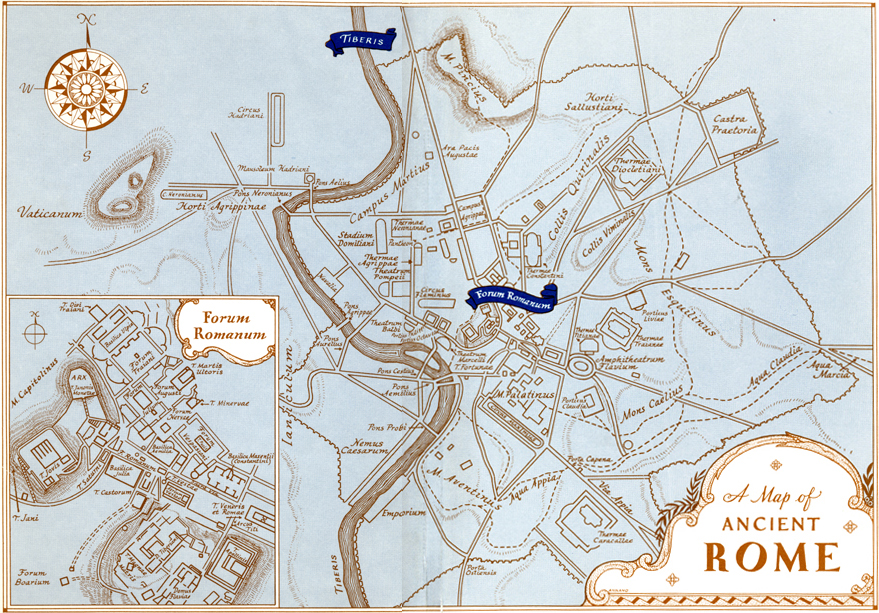
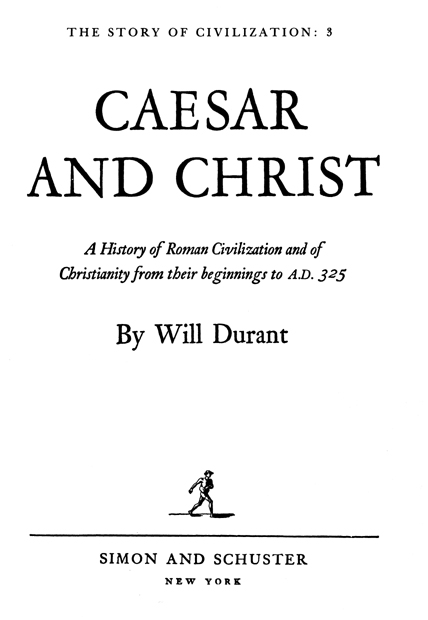
TO ARIEL
T HIS volume, while an independent unit by itself, is Part III in a history of civilization, of which Part I was Our Oriental Heritage, and Part II was The Life of Greece. War and health permitting, Part IV, The Age of Faith, should be ready in 1950.
The method of these volumes is synthetic history, which studies all the major phases of a peoples life, work, and culture in their simultaneous operation. Analytic history, which is equally necessary and a scholarly prerequisite, studies some separate phase of mans activitypolitics, economics, morals, religion, science, philosophy, literature, artin one civilization or in all. The defect of the analytic method is the distorting isolation of a part from the whole; the weakness of the synthetic method lies in the impossibility of one mind speaking with firsthand knowledge on every aspect of a complex civilization spanning a thousand years. Errors of detail are inevitable; but only in this way can a mind enchanted by philosophythe quest for understanding through perspectivecontent itself with delving into the past. We may seek perspective through science by studying the relations of things in space, or through history by studying the relations of events in time. We shall learn more of the nature of man by watching his behavior through sixty centuries than by reading Plato and Aristotle, Spinoza and Kant. All philosophy, said Nietzsche, has now fallen forfeit to history.
The study of antiquity is properly accounted worthless except as it may be made living drama, or illuminate our contemporary life. The rise of Rome from a crossroads town to world mastery, its achievement of two centuries of security and peace from the Crimea to Gibraltar and from the Euphrates to Hadrians Wall, its spread of classic civilization over the Mediterranean and western European world, its struggle to preserve its ordered realm from a surrounding sea of barbarism, its long, slow crumbling and final catastrophic collapse into darkness and chaosthis is surely the greatest drama ever played by man; unless it be that other drama which began when Caesar and Christ stood face to face in Pilates court, and continued until a handful of hunted Christians had grown by time and patience, and through persecution and terror, to be first the allies, then the masters, and at last the heirs, of the greatest empire in history.
But that multiple panorama has greater meaning for us than through its scope and majesty: it resembles significantly, and sometimes with menacing illumination, the civilization and problems of our day. This is the advantage of studying a civilization in its total scope and lifethat one may compare each stage or aspect of its career with a corresponding moment or element of our own cultural trajectory, and be warned or encouraged by the ancient aftermath of a modern phase. There, in the struggle of Roman civilization against barbarism within and without, is our own struggle; through Romes problems of biological and moral decadence signposts rise on our road today; the class war of the Gracchi against the Senate, of Marius against Sulla, of Caesar against Pompey, of Antony against Octavian, is the war that consumes our interludes of peace; and the desperate effort of the Mediterranean soul to maintain some freedom against a despotic state is an augury of our coming task. De nobis fabula narratur: of ourselves this Roman story is told.
I wish to acknowledge the invaluable and self-sacrificing aid of Wallace Brockway at every step in the preparation of this book; the patience of my daughter, Mrs. David Easton, and of Miss Regina Sands, in typing 1200 pages from my minuscule script; and above all to the affectionate toleration and protective guidance accorded me by my wife through many years of dull and plodding and happy scholarship.
Human, All Too Human, Eng. tr., New York, 1911, vol. II, p. 17.
Maps of Ancient Rome and Ancient Italy and Sicily will be found on the inside covers. A map of the Roman Empire faces .
INTRODUCTION
ORIGINS
Etruscan Prelude
800-508 B.C.
Q UIET hamlets in the mountain valleys, spacious pastures on the slopes, lakes upheld in the chalice of the hills, fields green or yellow verging toward blue seas, villages and towns drowsy under the noon sun and then alive with passion, cities in which, amid dust and dirt, everything from cottage to cathedral seems beautifulthis for two thousand years has been Italy. Throughout the whole earth, and wherever the vault of heaven spreads, there is no country so fair: thus even the prosaic elder Pliny spoke of his fatherland. Like a spine along the great peninsula ran the Apennines, shielding the west coast from the northeast winds, and blessing the soil with rivers that hurried to lose themselves in captivating bays. On the north the Alps stood guard; on every other side protecting waters lapped difficult and often precipitous shores. It was a land well suited to reward an industrious population, and strategically placed athwart the Mediterranean to rule the classic world.
The mountains brought death as well as splendor, for earthquakes and eruptions now and then embalmed the labor of centuries in ashes. But here, as usually, death was a gift to life; the lava mingled with organic matter to enrich the earth for a hundred generations.and the Renaissance, still run in Italian blood, only awaiting a good cause or argument. Nearly all the men are virile and handsome, nearly all the women beautiful, strong, and brave; what land can match the dynasty of genius that the mothers of Italy have poured forth through thirty centuries? No other country has been so long the hub of historyat first in government, then in religion, then in art. For seventeen hundred years, from Cato Censor to Michelangelo, Rome was the center of the Western world.
Those who are the best judges in that country, says Aristotle, report that when Italus became king of Oenotria, the people changed their name, and called themselves no longer Oenotrians but Italians. Just as the Romans called all Hellenes Graeci, Greeks, from a few Graii who had emigrated from north Attica to Naples, so the Greeks gradually extended the name Italia to all the peninsula south of the Po.
Doubtless many chapters of Italys story lie silent under her crowded soil. Remains of an Old Stone Age culture indicate that for at least 30,000 years before Christ the plains were inhabited by man. Between 10,000 and 6000 B.C. a neolithic culture appeared: a longheaded race called by ancient tradition Liguri and Siceli fashioned rude pottery with linear ornament, made tools and weapons of polished stone, domesticated animals, hunted and fished, and buried their dead. Some lived in caves, others in round huts of wattle and daub; from these cylindrical cottages architecture pursued a continuous development to the round House of Romulus on the Palatine, the Temple of Vesta in the Forum, and the Mausoleum of Hadrianthe Castel Sant Angelo of today.
About 2000 B.C. northern Italy was invadedpresumably not for the first timeby tribes from central Europe. They brought with them the custom of building their villages upon piles sunk in water, for safety from animal or human attack. They settled on Garda, Como, Maggiore, and the other enchanted lakes that still lure aliens to Italy. Later they moved south and, finding fewer lakes, built their homes upon land, but still upon a foundation of piles. Their habit of surrounding these settlements with rampart and moat passed down to form features of Roman camps and medieval chteaux. They pastured flocks and herds, tilled the soil, wove clothing, fired pottery; and out of bronze, which had appeared in Italy toward the end of the Neolithic Age (about 2500 B.C. ), they forged a hundred varieties of tools and weapons, including combs, hairpins, razors, tweezers, and other timeless implements.villages that their culture has received the name of terramare earth marlfrom the fertilizing potency of these remains. So far as we know, they were the direct ancestors of the basic population of Italy in historical times.
Font size:
Interval:
Bookmark:
Similar books «The Story of Civilization Volume III: Caesar and Christ»
Look at similar books to The Story of Civilization Volume III: Caesar and Christ. We have selected literature similar in name and meaning in the hope of providing readers with more options to find new, interesting, not yet read works.
Discussion, reviews of the book The Story of Civilization Volume III: Caesar and Christ and just readers' own opinions. Leave your comments, write what you think about the work, its meaning or the main characters. Specify what exactly you liked and what you didn't like, and why you think so.

